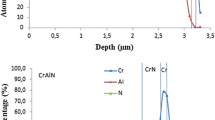Abstract
The oxidation mechanisms of sputtered microcrystalline Co−30Cr−5Al coatings were investigated by an acoustic emission technique, scatch test, transmission electron microscope (TEM), which was compared with CoCrAlY alloy. The results indicated that the beneficial effects of microcrystallization on the scale adhesion of Co−30Cr−5Al alloy are as follows: (1) The sputtered CoCrAl coating possesses a columnar structure, and oxidation along the columnar grains may form many micropegs which can anchor the scale to the metallic substrate, enhancing bonding of the scale. (2) The grain size of the sputtered coating is several orders of magnitude smaller than that of the cast alloy, and the grain size of oxide scales formed on the former is finer than that of the latter. The finer oxide scale may relieve the growth stresses during isothermal oxidation and partial thermal stresses during cooling by plastic deformation through grain sliding. The microcrystalline coating is more plastic than the cast alloy, which may relieve a certain amount of thermal stresses of the oxide scales. On the basis of oxide adhesion and plasticity, microcrystallization is more beneficial than the addition of reactive elements.
Similar content being viewed by others
References
G. R. Walkwork and A. Z. Hed,Oxid. Met. 3, 171 (1971).
G. R. Walkwork and A. Z. Hed,Oxid. Met. 3, 213 (1971).
F. Wang and H. Lou,Mater. Sci. Eng. B129, 279 (1990).
F. Wang, H. Lou, and W. Wu,Acta Metall. Sinica B5, 173 (1992).
F. Wang, H. Lou, and W. Wu,Vacuum 43, 749 (1992).
A. Ashary, G. H. Meier, and F. S. Pettit,Proc. Conf. High Temp. Prot. Coat., vol. 4, S. C. Singhal, ed. (Appl. Sci. Publ., Canada, 1984), 105.
C. Diot, P. Choquet, R. Mevrel,Proc. Intn. Conf. on Residual Stresses, G. Beck, S. Denis, and A Simon, eds., Elsevier Appl. Sci., London, (1989), pp. 273–278.
C. O. Moon and S. B. Lee,Oxid. Met. 39 (1993).
K. L. Luthra and C. L. Briant,Oxid. Met. 26, 397 (1986).
Y. I. Kuraki,Ceramic Handbook, D. Liu and S. Chen, transl. (Light Industry Press, Beijing, 1984), p. 584 (in Chinese).
P. Hancock and R. C. Hurst, inAdvances in Corrosion Science and Technology, vol. 4 (Plenum Press, New York, 1974), pp. 1–84.
J. Karch, R. Birringer, and H. Gleiter,Nature, 330 (1987).
C. S. Tedmon, Jr.,J. Electrochem. Soc. 114, 788 (1967).
Author information
Authors and Affiliations
Rights and permissions
About this article
Cite this article
Wang, F., Lou, H., Zhu, S. et al. The mechanism of scale adhesion on sputtered microcrystallized CoCrAl films. Oxid Met 45, 39–50 (1996). https://doi.org/10.1007/BF01046819
Received:
Issue Date:
DOI: https://doi.org/10.1007/BF01046819




